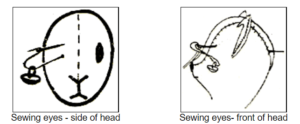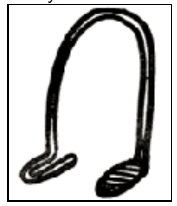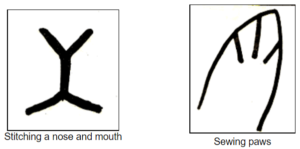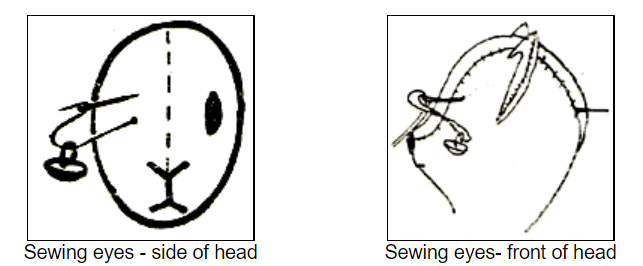Craft Patterns
To enlarge or reduce the size of patterns on this site you can either:
1) Print out the pattern (using your home printer), then take the printout to your local library or printery and enlarge on a photocopier OR
2) Use a computer graphics program to rescale the image on your computer, and then print out the pattern.
Cutting
For cutting out, place the pattern on the felt. Pin into position and cut out carefully. When using fur or material with a right or wrong side, and pairs of a pattern are being cut, the pattern must be reversed for the second piece.
Joining seams
– All seams are glove stitched on the right side of work unless otherwise stated.
– Glove stitch is over-sewing twice into each stitch.
What is appliqué craft?
To appliqué is to secure a smaller piece of felt to a larger felt surface with buttonhole stitch.
How to sew on glass eyes
Glass eyes come in pairs joined together with a piece of wire. Cut the wire 1/2″ from the eye and bend over to form a shank.
Generally it will be found that those animals which were traditionally hunted as prey have eyes at the side of their heads (e.g. rabbits and kangaroos), whilst the hunter animals (dogs, cats etc.) have eyes looking straight ahead.
To insert the eye of toy bunny rabbits, ducklings etc., thread a long needle with strong cotton, pass the needle from one side of the head to the other, thread on one eye and pass the needle back to the starting point; thread on second eye, draw the cotton tightly and tie very securely; cut cotton ends close to eye.

With toy animals whose eyes look out straight in front, each eye is looped on to a separate doubled thread and the needle inserted in the eye position and passed through to back of neck. Pass needle back to starting point, draw the cotton tightly and tie securely, cut cotton ends close to eye. The finished eyes should be well sunken into the head.
Support for Legs
Bend a piece of wire to make an arch, and bend ends for feet. Bind the feet and rough ends with adhesive tape or strips of material, 16 gauge wire is normally used.

Filling
When stuffing wire figures, be sure to pack the filling around the wire and avoid lumpiness (!). Use a wooden skewer to push filling into small areas, e.g. paws, feet, legs, etc. Brushed nylon filling is recommended as it is clean, non-allergic and retains its softness and pliability.
Kangaroo, Bambi Deer and Bunny Rabbit
How to stitch nose and mouth – see illustration below.
Craft stitches for Bunny Rabbit and Kangaroo Paws
See illustration below.

